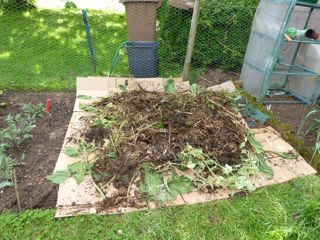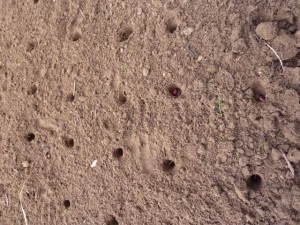
Our vegetable harvest has been pretty much a complete flop. We have giant pale marrows. Watery and with skins like toenails. Tomatoes tasting of fish and who wants new potatoes in September? All due to inattention to sowing times and now, nothing to look forward to but maudlin runner beans and leeks this winter.
It's sandy here and so nutrients are leached out all too easily. The soil needs to be improved or the vegetables will be even worse next time round. I am going for a two-pronged early autmn attack.
First, compost cake. Here's how. Round the garden there are various heaps of decaying vegetable matter. We've got grass cuttings, nitrogen rich, in a mound under one of the trees. Harvested stalks of old plants and non pernicious weeds live under a tarp on a slab of cardboard.

Lastly, all kitchen vegetable waste (except for the rude potato) go into a black vat like a tardis. Now is the time to put them all together. Oh and by the way, spuds can re-sprout from peelings. That's why they are out.
The base of the cake is thick layers of cardboard. To stop local tree roots using said compost as a juice bar. Some sort of backing is also needed. Chicken wire or old pallets are good. Then simply make up the layers of the different organic decaying matter. Either put in a thin layer of well rotted stable manure every third tier or sprinkle in a product called Garrota. Both act as an activator and bring the heap up to cooking temperature. Oxygen and water are the other critical ingredients. Play a hose over the heap during construction.
Stop building when heap is metre or so high. Cover it up with cardboard, old plastic sheeting or anything that won't blow away. The cooking of the heap will get underway with increased temperature accelerated by organic matter in mid decay.
The cover will get taken off now and again when it is raining. Beyond that, I'll turn it out onto the adjoining bed at the end of the year. Ready then to finally decompose in situ for next spring's crops.

Second, I've used green manures for empty bare patches of ground. Soil structure is damaged by standing uncovered. The winter rain batters down and the natrients get drained away. So here we have sowed winter beans and grazing rye. They will get chopped back down and turned into the ground when the crop has come up but is still young and succulent. This should give a bust of nutrients and improve the soil condition. Before that, it will act as a mulch and discourage weeds.
 Our vegetable harvest has been pretty much a complete flop. We have giant pale marrows. Watery and with skins like toenails. Tomatoes tasting of fish and who wants new potatoes in September? All due to inattention to sowing times and now, nothing to look forward to but maudlin runner beans and leeks this winter.
It's sandy here and so nutrients are leached out all too easily. The soil needs to be improved or the vegetables will be even worse next time round. I am going for a two-pronged early autmn attack.
First, compost cake. Here's how. Round the garden there are various heaps of decaying vegetable matter. We've got grass cuttings, nitrogen rich, in a mound under one of the trees. Harvested stalks of old plants and non pernicious weeds live under a tarp on a slab of cardboard.
Our vegetable harvest has been pretty much a complete flop. We have giant pale marrows. Watery and with skins like toenails. Tomatoes tasting of fish and who wants new potatoes in September? All due to inattention to sowing times and now, nothing to look forward to but maudlin runner beans and leeks this winter.
It's sandy here and so nutrients are leached out all too easily. The soil needs to be improved or the vegetables will be even worse next time round. I am going for a two-pronged early autmn attack.
First, compost cake. Here's how. Round the garden there are various heaps of decaying vegetable matter. We've got grass cuttings, nitrogen rich, in a mound under one of the trees. Harvested stalks of old plants and non pernicious weeds live under a tarp on a slab of cardboard.
 Lastly, all kitchen vegetable waste (except for the rude potato) go into a black vat like a tardis. Now is the time to put them all together. Oh and by the way, spuds can re-sprout from peelings. That's why they are out.
The base of the cake is thick layers of cardboard. To stop local tree roots using said compost as a juice bar. Some sort of backing is also needed. Chicken wire or old pallets are good. Then simply make up the layers of the different organic decaying matter. Either put in a thin layer of well rotted stable manure every third tier or sprinkle in a product called Garrota. Both act as an activator and bring the heap up to cooking temperature. Oxygen and water are the other critical ingredients. Play a hose over the heap during construction.
Stop building when heap is metre or so high. Cover it up with cardboard, old plastic sheeting or anything that won't blow away. The cooking of the heap will get underway with increased temperature accelerated by organic matter in mid decay.
The cover will get taken off now and again when it is raining. Beyond that, I'll turn it out onto the adjoining bed at the end of the year. Ready then to finally decompose in situ for next spring's crops.
Lastly, all kitchen vegetable waste (except for the rude potato) go into a black vat like a tardis. Now is the time to put them all together. Oh and by the way, spuds can re-sprout from peelings. That's why they are out.
The base of the cake is thick layers of cardboard. To stop local tree roots using said compost as a juice bar. Some sort of backing is also needed. Chicken wire or old pallets are good. Then simply make up the layers of the different organic decaying matter. Either put in a thin layer of well rotted stable manure every third tier or sprinkle in a product called Garrota. Both act as an activator and bring the heap up to cooking temperature. Oxygen and water are the other critical ingredients. Play a hose over the heap during construction.
Stop building when heap is metre or so high. Cover it up with cardboard, old plastic sheeting or anything that won't blow away. The cooking of the heap will get underway with increased temperature accelerated by organic matter in mid decay.
The cover will get taken off now and again when it is raining. Beyond that, I'll turn it out onto the adjoining bed at the end of the year. Ready then to finally decompose in situ for next spring's crops.
 Second, I've used green manures for empty bare patches of ground. Soil structure is damaged by standing uncovered. The winter rain batters down and the natrients get drained away. So here we have sowed winter beans and grazing rye. They will get chopped back down and turned into the ground when the crop has come up but is still young and succulent. This should give a bust of nutrients and improve the soil condition. Before that, it will act as a mulch and discourage weeds.
Second, I've used green manures for empty bare patches of ground. Soil structure is damaged by standing uncovered. The winter rain batters down and the natrients get drained away. So here we have sowed winter beans and grazing rye. They will get chopped back down and turned into the ground when the crop has come up but is still young and succulent. This should give a bust of nutrients and improve the soil condition. Before that, it will act as a mulch and discourage weeds. 